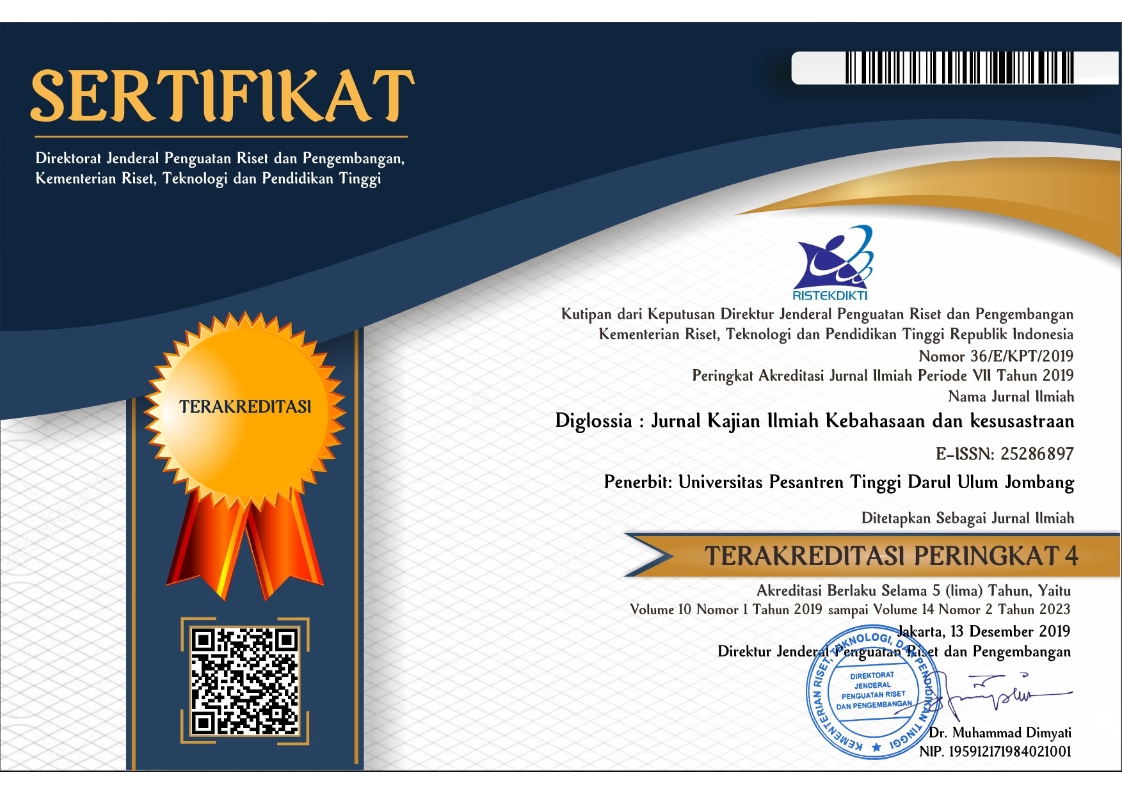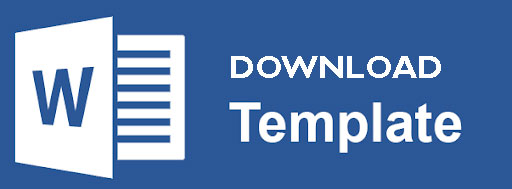GAYA BAHASA MARIO TEGUH DALAM EPISODE “JOMBLO MULIA” 8 JUNI 2014 Kajian Retorika LANGUAGE STYLE OF MARIO TEGUH IN “JOMBLO MULIA” ON JUNE 8, 2014 EPISODE Rhetorics Study
DOI:
https://doi.org/10.26594/diglossia.v7i2.565Abstract
Abstrak
Retorika merupakan sebuah teknik pemakaian bahasa sebagai seni.Seni retorika bemacam-macam dan setiap penutur mempunyai kekhususan dalam memilih seni retorika dalam tuturannya. Mario Teguh sebagai seorang motivator juga menggunakan seni retorika tertentu. Seni retorika yang digunakan Mario Teguh meliputi gaya bahasa dan komunikasi nonverbal. Tujuan penelitian ini adalah untuk mendeskripsikan seni retorika yang berupa gaya bahasa dan komunikasi nonverbal yang digunakan Mario Teguh dalam tuturannya. Hasil penelitian menunjukkan gaya bahasa yang digunakan Mario Teguh meliputi gaya bahasa berdasarkan struktur kalimat (klimaks, antiklimaks, antitesis, repetisi), berdasarkan langsung tidaknya makna (asindenton, polisindenton, eufimismus, pertanyaan retoris), dan bahasa kiasan yang meliputi majas personifikasi, sinekdoke, hiperbola, paradoks, metafora. Sebagai komunikasi nonverbal, Mario Teguh juga menerapkan faktor kinesik yang meliputi ekspresi wajah, gerakan tangan, penampilan dan postur; proksemik; dan paralingual.
kata kunci : retorika, gaya bahasa, komunikasi nonverbal
Abstract
Rhetoric is a technique of using language as an art. There are many kinds of the art of rhetoric and every speaker has his/her own specificity in selecting the art of rhetoric in his/her speech. Mario Teguh as a motivator also uses certain rhetorical art. The rhetoric arts used by Mario Teguh are language style and nonverbal communication. The purpose of this study was to describe the art of rhetoric which are in the form of language style and nonverbal communication used by Mario Teguh in his speech. The results showed that the language style used by Mario Teguh are language style which is based on the structure of the sentence (the climax, anticlimax, antithesis, repetition) and based on the direct or the absence of meaning (asyndeton, polisydenton, euphemisms, a rhetorical question). The figurative languages used are personification, sinecdoc, hyperbole, paradox, and metaphor. As nonverbal communication, Mario Teguh also applied kinesic factors which include facial expressions, hand gestures, performance and posture; proxemic; and paralingual.
keywords: retorics, language style, nonverbal communication
Downloads
Published
Issue
Section
License
- Authors who submit a manuscript to this journal and accepted for publication, copyright of the article shall be assigned to the authors of the article.
- Copyright encompasses exclusive rights to reproduce and deliver the article in all forms and media, including reprints, photographs, and any other similar reproductions, as well as translations. The reproduction of any part of this journal, its storage and transmission of databases by any forms or media, such as electronic, mechanical copies, photocopies, and recordings will be allowed by Diglossia
- Editorial Board of Diglossia tries to make every effort to ensure that no wrong or misleading data, opinions or statements be published in the journal. The contents of the articles published to Diglossia are sole and exclusive responsibility of their respective authors.
- The copyright form should be filled with respect to article and be signed originally and sent scanned document file (softcopy) and the article to our email, jurnal.diglossia@fbs.unipdu.ac.id or sent it to the Editorial Office in the form of original hard copy and the article in softcopy form on Flash Disc or Compact Disc, to;Diglossia: Jurnal Kajian Ilmiah Kebahasaan dan Kesusastraan
Prodi Sastra Inggris Fakultas Bisnis dan Bahasa
Universitas Pesantren Tinggi Darul Ulum
Kompleks Pondok Pesantren Darul Ulum
Rejoso Peterongan Jombang Jawa Timur 61481






